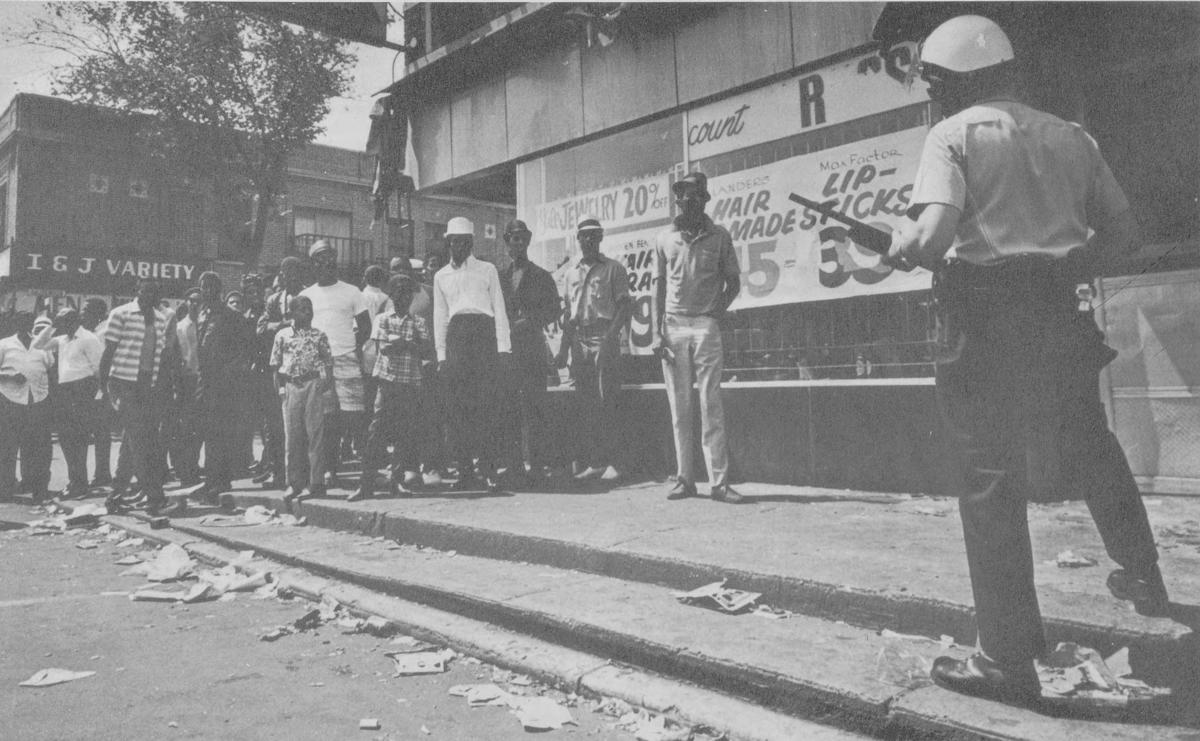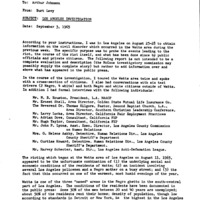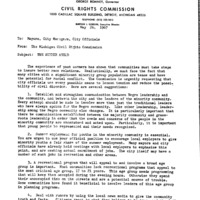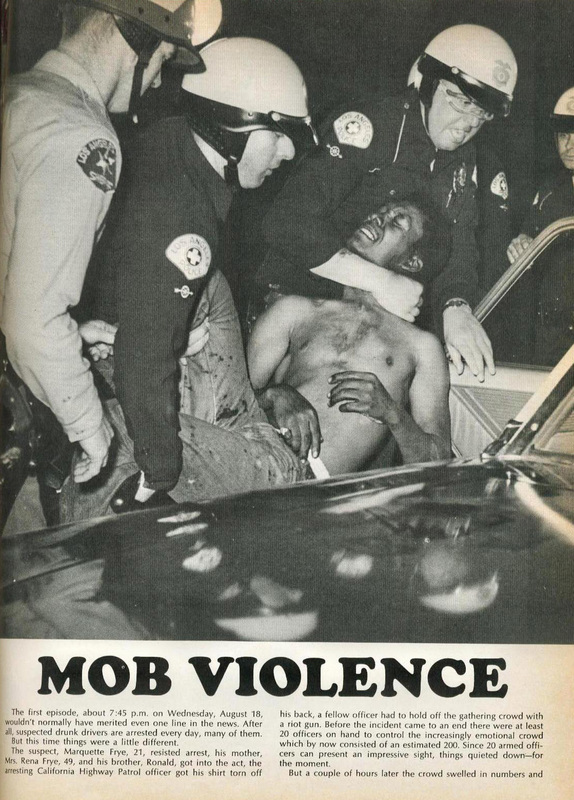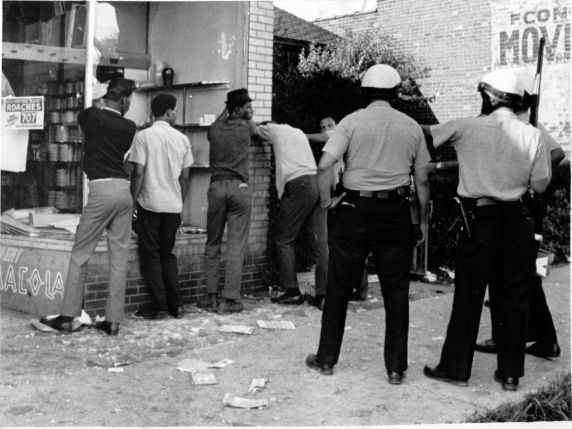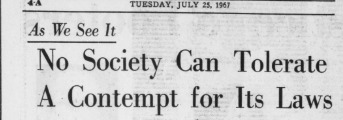III. Uprising and Occupation, 1967
The Detroit Uprising of 1967 was a violent and divisive time for the city and part of a wave of urban unrest that spread across the nation in the mid-to-late 1960s. Incidents of police brutality and harassment of African Americans were the immediate triggers for almost every episode of "civil unrest" during this era. In Detroit, the specific trigger was a police raid on a "blind pig," an after-hours bar, in the early morning hours of July 23, 1967. Officers in the Detroit Police Department arrested 85 African Americans, and this time people fought back. The "civil disorder"--alternatively labeled a riot, a rebellion, and an uprising--lasted for nine days and resulted in at least 43 deaths (the official count is 33 African Americans and 10 white people), around 7,200 arrests, and significant property damage. The governor of Michigan declared a state of emergency and mobilized the National Guard, and the president of the United States eventually sent in U.S. Army paratroopers to occupy the city of Detroit.
While systematic police brutality and mistreatment of Detroit's African American residents served as the catalyst, the 1967 Uprising also was the culmination of many underlying forces, including deep patterns of racial segregation and discrimination in housing, education, and employment. The typical "rioter" was an unemployed African American male between 15 and 24 years old. In the aftermath, the investigations seeking to pinpoint the cause of the civil unrest blamed "white racism," housing segregation, black male unemployment, and especially widespread African American resentment of police brutality. A survey of African Americans in Detroit revealed a similar indictment: police brutality was the number one cause of the civil disturbance, followed closely by crowded and substandard housing, unemployment, and poverty (see right).
Predicting "Civil Disorder" in Detroit
The 1967 Uprising shocked the white leadership and residents of Detroit, but civil rights organizations and African American leaders had been predicting a major racial disturbance for years. In the fall of 1965, the Michigan Civil Rights Commission (MCCR) conducted a study of the so-called Watts Riot in Los Angeles (below left), which began with a police brutality incident and resulted in 34 fatalities, with the specific goal of preventing a similar occurrence in Detroit. The MCCR report blamed Watts on pervasive police brutality, lack of black officers in the Los Angeles Police Department, poverty and slum conditions, and racial segregation in housing. The report warned that Detroit had the same problems of thousands of black residents living "in abject poverty, exploited by merchants and property owners, with little hope of improving their or their childrens' lot." The MCCR also argued that officers who committed brutality and misconduct had to be punished, and "we must concentrate greater efforts on our police-Negro relations program." The MCCR concluded:
These warnings accelerated in the aftermath of the 'near-miss riot' known as the Kercheval Incident of 1966. That episode, which began with an unjustified police crackdown on an anti-police brutality organization, gave the DPD and Mayor Jerome Cavanagh a false sense of security that their militarized police force could handle any unrest with its sophisticated "riot prevention" methods. The liberal Cavanagh administration simultaneously pledged Total Action Against Poverty and equal treatment under the law for all citizens, promises that rang hollow in Detroit's poor, black, over-policed neighborhoods. In response to Kercheval, a coalition of black leaders called for recruitment of 1,000 African American police officers, racial integration of the public schools, and a "crash program to deal with the issues of ghetto housing and slum living conditions." More radical groups embraced Black Power and contended that white liberalism was the problem, not the solution.
In May 1967, the Michigan Civil Rights Commission sounded another alarm in a memo (right) titled "The Summer Ahead," telling mayors statewide that cities with large black populations had the "potential for racial conflict." The MCCR recommended that cities:
- Establish communication with the leaders of newer grassroots organizations and not only the "traditional leaders who have always spoken for the Negro community"
- "Summer employment for youths in the minority community is essential"
- Recreational programs for teenagers and young adults
- Dispel racial rumors
- Provide evidence of progress to "victims of segregation and discrimination in jobs, housing, education, public accommodations, or law enforcement"
- "The Police Department should reemphasize the equal application of its rules ands regulations regarding courtesy, conduct, and language. Many incidents of civil disorder have escalated from an incident involving a citizen and a police officer"
In many ways, it was already too late. Most African Americans in Detroit lived in completely segregated neighborhoods, and the poorest black communities faced extremely high rates of unemployment and police brutality. The Detroit Police Department still consisted overwhelmingly of white men, despite decades of demands by civil rights groups to diversify the force. Since 1958, the NAACP and other African American groups had made the problem of police brutality a centerpiece of the civil rights agenda in Detroit, but very little had changed. The liberal Cavanagh administration, in power since 1962, repeatedly promised equal treatment under the law but believed that the DPD could investigate itself and therefore did nothing substantive to curb police brutality against black citizens. Paralleling national trends, the Cavanagh administration's embrace of a "war on crime" and "get-tough" policing, through militarized forces such as the Tactical Mobile Unit, had only exacerbated brutality and worsened police-community relations in Detroit. The DPD during the Cavanagh years even illegally harassed and framed civil rights and black power activists who sought to expose police brutality and demand reforms.
After the 1967 Uprising, the city of Detroit became a leading example of the nation's "urban crisis," a justification for law-and-order conservatives and law-and-order liberals of the necessity of military-style policing in the inner city, and a place where black power radicals believed that the African American community had finally rebelled against decades of racial discrimination and police oppression. The Kerner Commission, established by President Lyndon Johnson to investigate the causes of the "civil disorders" in Detroit and other American cities, placed responsibility on racial segregation and discrimination in housing, education, employment, and law enforcement. The police were "not just a 'spark' factor," the Kerner Report emphasized: "to some Negroes, police have come to symbolize white power, white racism and white repression." Most of all, the Kerner Commission concluded:
Uprisings from a National Perspective
During the mid-to-late 1960s, at least 250 cities in the United States experienced major incidents of "civil disorder." Before the summer of 1967, when white leaders of Detroit boasted of their "model city" for race relations, they were particuarly drawing a contrast to the explosions of racial violence in Harlem (1964) and Watts (1965). In Harlem, the fatal shooting of an African American teenager by a white police officer led to a massive uprising that spread quickly to other black neighborhoods in the city. In Watts, police brutality during the arrest of two African American men led a crowd of bystanders to fight back, and the situation quickly spiraled out of control. Six days of unrest brought mass arrests of African American residents, many incidents of police brutality from the Los Angeles Police Department, 34 deaths (almost all black residents), and occupation of the area by the U.S. Army. The chief of the LAPD blamed the rioting on "monkeys in a zoo" and denied that any police brutality happened on his watch.
The civil disorders of the mid-1960s intensified the war on urban crime that the federal government, and many state governors and big-city mayors, had already declared. Many conservatives blamed the "riots" in Harlem and Watts on civil rights agitators, black power radicals, and black criminality. Many liberals emphasized the role of racial discrimination and poverty in the urban unrest of the 1960s but also blamed the criminality of the rioters themselves and pledged to get tougher on crime and disorder in poor black neighborhoods. President Lyndon Johnson's declarations of war on both poverty and crime epitomized the white liberal promise to improve the underlying conditions of racial inequality and urban poverty but also to crack down hard on urban crime and civil unrest. A majority of white Americans also supported police force against "rioters," including shoot-to-kill orders for "looters."
In July 1967, terrible racial violence broke out in Newark, New Jersey, just two weeks before the start of the Detroit Uprising. The civil unrest in Newark began with an episode of police brutality, lasted for six days, and claimed the lives of 26 people (all but two African American). President Johnson blamed a conspiracy of black power radicals for inciting urban riots and established the Kerner Commission to investigate, leading to its famous and hard-hitting conclusion that "white racism" was the fundamental cause. The wave of urban unrest crested in the spring of 1968, after the assassination of Martin Luther King, Jr., with massive protest demonstrations and episodes of racial violence in more than 100 cities and towns. In the state of Michigan, racial disturbances and civil unrest during 1967-1968 also happened in other cities with sizable and segregated black populations, including Flint, Battle Creek, Kalamazoo, Benton Harbor, Pontiac, and Grand Rapids.
In the summer of 1967, the Johnson administration responded to the racial unrest in Newark and Detroit with military force and promises to ensure "law and order." Lyndon Johnson stated that the riots had "nothing to do with civil rights" and shifted the focus away from the cause of police brutality to the criminal and disorderly actions of some of the residents of the affected neighborhoods. The president blamed the "apostles of violence," by which he meant black power activists, and declared: "There is no American right to loot stores, or to burn buildings, or to fire rifles from the rooftops. That is crime." The Johnson administration responded with the military occupation of Detroit, and the long-term militarization of local police departments was one of many consequences of the Crime Control and Safe Streets Act of 1968, which Congress passed and the president signed in the aftermath.
Riot/Rebellion/Uprising: What's in a Name?
During the mid-to-late 1960s, the most common description for these events in the media and in political rhetoric was "riots." Some civil rights organizations, especially moderate-to-liberal groups such as the Detroit Urban League, also used the framework of "riot." The label of "riot" imposes both violence and criminality on the civilians involved. "Rioters" become the villains in the story, responsible for victimizing law enforcement who are acting in their own self-defense and in defense of the American social order. The label of "riot" therefore justified state violence at the time, including the official findings that all law enforcement killings of civilians were "justifiable homicides," and has continued to retroactively justify such state violence in historical memory and interpretation.
Black power organizations, in particular, labeled these events "rebellions" or "uprisings," emphasizing both their political nature and the ways in which they functioned as communal resistance to oppressive law enforcement and other racist institutions.
The Kerner Commission chose the more neutral language of "civil disorders" and emphasized the role of white racism and white institutions in causing "mob violence." This investigative commission tried to have it both ways, rejecting President Johnson's theory that a black power conspiracy was behind the "urban disorders" but also stating that black militants had "repeatedly forecast and called for violence" [note: warning that racist institutions will cause violence and calling for it are two very different things] and therefore "helped to create an atmosphere that contributed to the outbreak of disorder." Conservatives much more strongly blamed the "riots" on black power radicals. Intriguingly, this is also a political interpretation of the urban unrest, rather than the more more spontaneous and disorganized criminal activities conveyed by the term "riot."
Our exhibit, based on discussions by the research team that created this section and by the full research team, made a deliberate choice to use the label of "uprising," although we also believe that "rebellion" is appropriate. "Uprising" is designed to emphasize the political essence of the events in question and the ways in which a significant percentage of the African American community in Detroit rose up to resist and rebel against the immediate and longer-term causes of police brutality, state violence, and structural racism. "Uprising" is also employed to shift attention away from the blanket imposition of criminality onto tens of thousands of African American residents of Detroit and to question the official and indiscriminate labeling of these residents as "rioters" and "looters" and "snipers," which functioned to justify both indiscriminate and targeted state violence. "Uprising" also shifts attention to the criminal actions of the state, and of law enforcement officials in particular, that both caused the racial explosion in Detroit in July 1967 and made the event more deadly and violent by escalating force against protesters who were mostly nonviolent. Despite the wild rumors of black power snipers circulated by law enforcement and the news media, the fraction of individuals in Detroit who broke specific laws were either violating a state-of-emergency curfew imposed to quell the uprising, or were guilty at worst of misdemeanor property offenses, which the government and the media labeled "looting" but which were also crimes of poverty against a system where white people from outside the community owned most of the businesses and rental housing. (Recall the Michigan Civil Rights Commission's warning that ghetto residents lived "in abject poverty, exploited by merchants and property owners"). "Uprising" does not mean that the events in question were organized in advance, but rather that they constituted both individual and collective acts of resistance and rebellion against a racist political and economic system enforced by a racist police department.
At least 47 people, a total higher than the official undercount, lost their lives in the Detroit Uprising (map, below left). Of this total, 37 were African American. Law enforcement and military units killed at least 34 of the civilian casualities, with 7 more listed as "unknown." As the Fatalities and Victims page explains in detail, almost all were unarmed and posed no threat to the agents of the state who killed them.
Media coverage played a key role in shaping the interpretations of what happened in Detroit during July 1967, and the mainstream newspapers and broadcast networks generally reinforced the police and government framework of a criminal riot and even a radical criminal conspiracy. The Detroit newspapers, for example, published wild and unfounded rumors promoted by the DPD about a black power sniper conspiracy to kill law enforcement officers, which justified the excessive and vastly disproportionate violence of the police against mostly unarmed civilians. On July 25, in an editorial titled "No Society Can Tolerate a Contempt for Its Laws," the Free Press labeled the event a "hoodlum uprising" that "became a riot" because the "hooligans set off the tinderbox."
The Free Press also blamed the "rioters" rather than the police response for the fear felt by African American residents of Detroit: "The rioters reaped a harvest of booty. For the innocents, there was only fear. They huddled in their homes in the heart of the riot area, the nonviolent victims of a terror which others had created and others were trying to control." The Michigan Chronicle, while certainly critical of the breakdown of law and order, also tried harder to understand its causes and offered the analysis that "the people, mostly the poor Negroes, have decided to take out their frustration and hatred for being the bottom of the social and economic structure of our society."
The media segment at the bottom right is by a white Detroit television news reporter during the early days of the Uprising and is one of many examples of the power and danger of the "riot" language used to describe these events. The brief segment starts with African Americans milling around in the middle of the street; none seem armed, and none are doing anything violent. The reporter presents himself, as a shocked white resident of Detroit (or perhaps its suburbs), as the real victim in the story he is reporting, including these lines:
- "All newsmen around the country have watched for years at television pictures of what happens in a riot,or in a racial disturbance, or just a general disturbance, call it what you will."
- "We always wonder what it's going to be like when we're right in the center of one, and you're the target"
- "All of the sudden you find that there are folks who live in the same town you do . . . who hate you enough at least on given occasions to attack you"
- "I suspect we all could list five or six reasons why something like this starts and why it continues"
- "It doesn't make any sense at all"
Fatalities during the 1967 Detroit Uprising (larger map here)
Please visit the Fatalities and Victims page for analysis of these patterns.
Sources:
Sidney Fine, Violence in the Model City: The Cavanagh Administration, Race Relations, and the Detroit Riot of 1967 (Lansing: Michigan University Press, 2007)
Patrick Ball, “Violence in Blue,” Granta Magazine (March 2016), https://granta.com/violence-in-blue/
Loukas Loukopoulos, The Detroit Police Department: A Research Report (Detroit: Committee on Public Awareness, May 1970)
Joseph L. Hudson Papers, Bentley Historical Library, University of Michigan
Michigan Department of Civil Rights, Detroit Office, RG 80-17, Michigan State Archives, Lansing, Michigan
Kerner Commission, Report of the National Advisory Commission on Civil Disorders (March 1968),
Alex Elkins, “The Origins of Stop-and-Frisk,” Jacobin (May 9, 2015), https://www.jacobinmag.com/2015/05/stop-and-frisk-dragnet-ferguson-baltimore/
"Problems Ignored: Riots in Newark Have Deep Roots," The Michigan Chronicle, July 29, 1967
Elizabeth Hinton, From the War on Poverty to the War on Crime: The Making of Mass Incarceration in America (Cambridge: Harvard University Press, 2016)
Feagin, Joe R., and Paul B. Sheatsley. “Ghetto Resident Appraisals of a Riot.” The Public Opinion Quarterly, vol. 32, no. 3, 1968, pp. 352–362. JSTOR, JSTOR, www.jstor.org/stable/2747641
George Romney Papers, Bentley Historical Library, University of Michigan
Sauter and Hines, Nightmare in Detroit (1968)
Jerome P. Cavanagh Collection, Walter P. Reuther Library, Wayne State University
Detroit News, July 26, 1967
Michigan Chronicle, August 5, 1967

